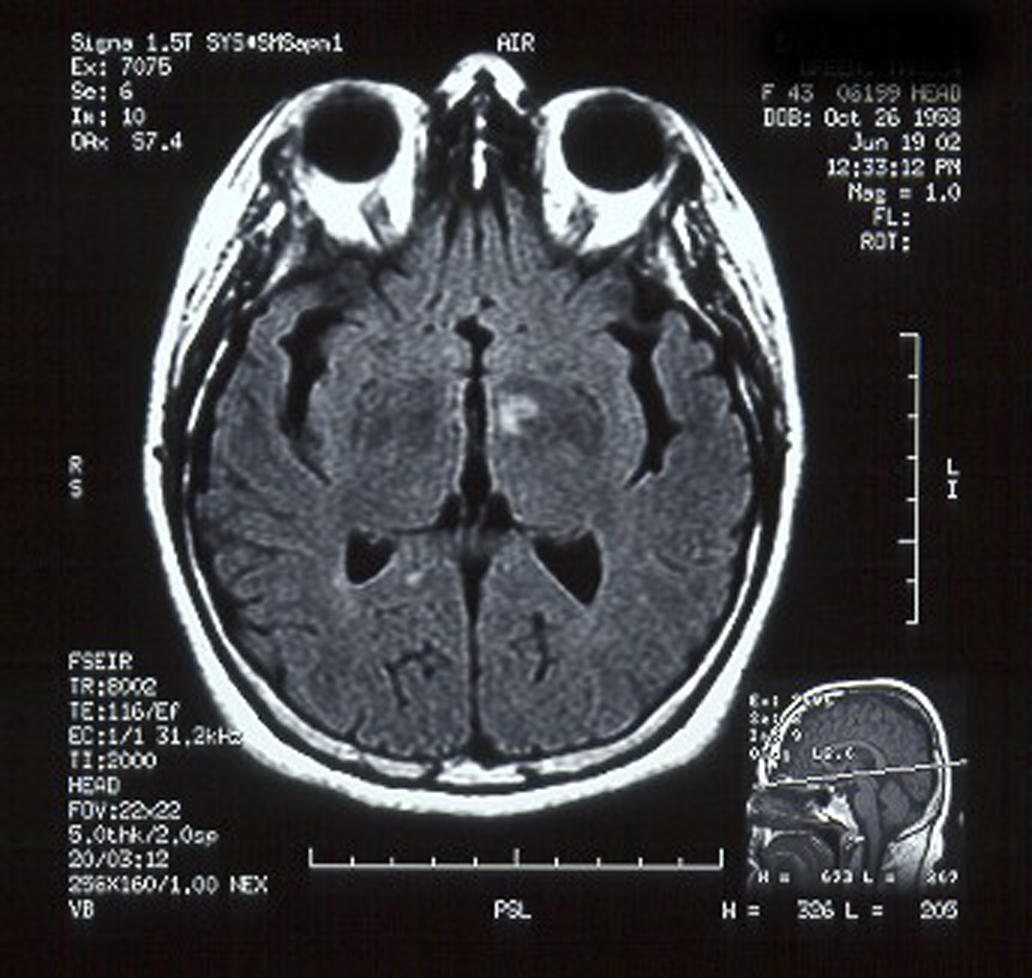| Journal of Medical Cases, ISSN 1923-4155 print, 1923-4163 online, Open Access |
| Article copyright, the authors; Journal compilation copyright, J Med Cases and Elmer Press Inc |
| Journal website http://www.journalmc.org |
Case Report
Volume 1, Number 3, December 2010, pages 92-93
The Accountant Who Lost Arithmetic: A Case Report of Acalculia With a Left Thalamic Lesion
Matthew B. Jensen
Comprehensive Stroke Program, Department of Neurology, School of Medicine and Public Health, University of Wisconsin, 1685 Highland Ave, room 7273, Madison, WI 53705-2281, USA
Manuscript accepted for publication October 4, 2010
Short title: Acalculia With Left Thalamic Lesion
doi: https://doi.org/10.4021/jmc61w
| Abstract | ▴Top |
Acalculia is usually from dysfunction of the dominant parietal cortex. We report a case of acalculia associated with a lesion of the left thalamus.
Keywords: Acalculia; Arithmetic; Thalamus
| Introduction | ▴Top |
Acalculia, a deficit of simple math (namely arithmetic), is a well-described part of the Gerstmann’s syndrome, which can be seen with damage to the left angular gyrus [1]. As a higher cognitive function, mathematics would traditionally be localized to cortex, but there have been a few case reports of acalculia following thalamic lesions. We report a patient who gradually lost the ability to do arithmetic and was found to have a small left thalamic lesion.
| Case Report | ▴Top |
A 43-year-old right-handed female accountant presented with a four month history of progressive acalculia that caused her to stop working. She also had developed occasional word-finding difficulty, mild short-term memory loss, mild headaches, and one week of a burning sensation in her right face, arm, and leg.
Examination was normal except that serial subtraction was labored and slow, although accurate, and there was diminished temperature sensation throughout the right side. Neuropsychological assessment confirmed mild to moderate deficits in mathematical skills, with otherwise normal cognition.
Magnetic resonance imaging (MRI) demonstrated a 10 mm T2/FLAIR hyperintensity in the anterior/medial left thalamus with a 1 mm area of enhancement (Fig. 1). Cerebrospinal fluid was normal with no oligoclonal bands and a normal IgG index.
 Click for large image | Figure 1. FLAIR hyperintensity in the anteromedial left thalamus. |
Subsequent MRI one and two months later showed the lesion to be smaller and then completely resolved. Visual and auditory evoked potentials were normal. The patient later recalled an episode of right-sided numbness that came and went over the course of one month, 16 years prior.
| Discussion | ▴Top |
The inability to manipulate numbers mentally for simple calculation is referred to as acalculia, coined by Henschen in 1919 [2]. Hecaen proposed division of acalculia into three groups in 1961: acalculia secondary to alexia and agraphia for numbers, acalculia from spatial disorganization of numbers, and anarithmetria or the isolated loss of calculation [2]. McCloskey and others have delineated this further [3].
Acalculia is most frequently found with lesions of left parietal cortex, often with aphasia, spatial acalculia, however, is usually with damage to the right parietal cortex [2]. This case is the sixth report to our knowledge of acalculia from thalamic pathology. One case involved a tumor of the posterior left thalamus [4]. The other four were thalamic infarcts, three on the left and one on the right [5, 6].
The ability to count was shown in experiments of macaque monkeys, with single neuron recordings demonstrating specific neurons firing maximally to specific numbers [7]. Mathematics, as a higher cognitive function, would traditionally be localized to the cortex, but these case reports would suggest thalamic participation. An experiment during human neurosurgery showed that direct stimulation of the left thalamus in humans causes faster counting with more errors, while stimulating the right thalamus causes slower counting also with more errors [8]. A separate experiment during human neurosurgery found changes to firing patterns of thalamic neurons during mental arithmetic [9].
Our patient’s lesion was in the left thalamus, and on testing, her acalculia most closely resembled the anarithmetric type. Resolution of the lesion and the prior episode of transient sensory loss suggested an autoimmune, likely demyelinating, pathology as the cause of her syndrome. These case reports suggest a role for the left thalamus in the process of calculation, perhaps as part of a pathway connecting the left angular gyrus to other cortical areas such as the left lateral prefrontal cortex. Further study integrating lesions with functional neuroimaging would be helpful in learning more about the functional anatomy of mathematics.
| References | ▴Top |
- Kahn H, Whitaker H. Acalculia: an historical review of localization. Brain Cogn 1991;17(2):102-115.
pubmed doi - Denburg N, Tranel D. Acalculia and disturbances of the body schema. In: Heilman K, Valenstein E, eds. Clinical Neuropsychology. New York Oxford, 2003.
- McCloskey M, Aliminosa D, Sokol S. Facts, rules, and procedures in normal calculation: evidence from multiple single-patient studies of impaired arithmetic fact retrieval. Brain Cogn 1991;17(2):154-203.
pubmed doi - Roosen N, Cras P, Paquier P, Martin J. Primary thalamic malignant fibrous histiocytoma of the dominant hemisphere causing severe neuropsychological symptoms. Clin Neuropathol 1989;8(1):16-21.
pubmed - Bogousslavsky J, Regli F, Assal G. The syndrome of unilateral tuberothalamic artery territory infarction. Stroke 1986;17(3):434-441.
pubmed - Mendez M, Papasian N, Lim G. Thalamic acalculia. J Neuropsychiatry Clin Neurosci 2003;15(1):115-116.
pubmed doi - Nieder A, Freedman D, Miller E. Representation of the quantity of visual items in the primate prefrontal cortex. Science 2002;297(5587):1708-1711.
pubmed doi - Ojemann G. Mental arithmetic during human thalamic stimulation. Neuropsychologia 1974;12(1):1-10.
pubmed doi - Kim J, Ohara S, Lenz F. Mental arithmetic leads to multiple discrete changes from baseline in the firing patterns of human thalamic neurons. J Neurophysiol 2009;101(4):2107-2119.
pubmed doi
This is an open-access article distributed under the terms of the Creative Commons Attribution License, which permits unrestricted use, distribution, and reproduction in any medium, provided the original work is properly cited.
Journal of Medical Cases is published by Elmer Press Inc.


